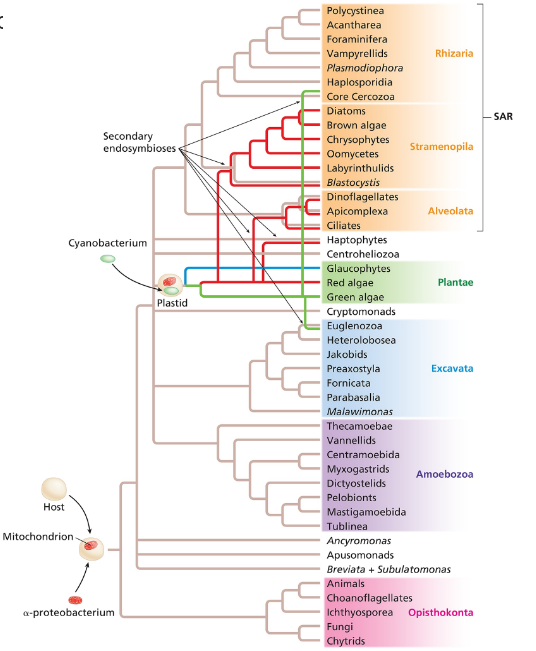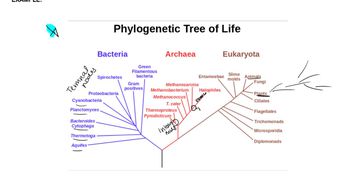What is the evidence that transfer of DNA from the organelles to the nucleus continues to occur?
Table of contents
- 1. Introduction to Genetics51m
- 2. Mendel's Laws of Inheritance3h 37m
- 3. Extensions to Mendelian Inheritance2h 41m
- 4. Genetic Mapping and Linkage2h 28m
- 5. Genetics of Bacteria and Viruses1h 21m
- 6. Chromosomal Variation1h 48m
- 7. DNA and Chromosome Structure56m
- 8. DNA Replication1h 10m
- 9. Mitosis and Meiosis1h 34m
- 10. Transcription1h 0m
- 11. Translation58m
- 12. Gene Regulation in Prokaryotes1h 19m
- 13. Gene Regulation in Eukaryotes44m
- 14. Genetic Control of Development44m
- 15. Genomes and Genomics1h 50m
- 16. Transposable Elements47m
- 17. Mutation, Repair, and Recombination1h 6m
- 18. Molecular Genetic Tools19m
- 19. Cancer Genetics29m
- 20. Quantitative Genetics1h 26m
- 21. Population Genetics50m
- 22. Evolutionary Genetics29m
3. Extensions to Mendelian Inheritance
Organelle DNA
Problem 9
Textbook Question
Consider the phylogenetic tree presented in the following figure (Figure 17.17). How were the origins of secondary endosymbiosis in the brown algae determined?

 Verified step by step guidance
Verified step by step guidance1
Examine the phylogenetic tree in Figure 17.17 to identify the placement of brown algae and their evolutionary relationships with other organisms.
Understand the concept of secondary endosymbiosis, which occurs when a eukaryotic organism engulfs another eukaryotic organism that has already undergone primary endosymbiosis, leading to the acquisition of additional organelles such as chloroplasts.
Analyze the genetic and molecular evidence, such as the presence of specific genes or DNA sequences in brown algae, that indicate the origin of their chloroplasts through secondary endosymbiosis.
Compare the chloroplasts of brown algae with those of other groups, such as red algae and green algae, to determine the likely ancestral lineage of the engulfed eukaryote.
Use the branching patterns and shared genetic markers in the phylogenetic tree to trace the evolutionary events that led to the secondary endosymbiosis in brown algae, identifying the timing and relationships with other lineages.
 Verified video answer for a similar problem:
Verified video answer for a similar problem:This video solution was recommended by our tutors as helpful for the problem above
Video duration:
2mPlay a video:
Was this helpful?
Key Concepts
Here are the essential concepts you must grasp in order to answer the question correctly.
Phylogenetic Trees
Phylogenetic trees are diagrams that represent the evolutionary relationships among various biological species based on their genetic characteristics. They illustrate how species diverged from common ancestors over time, allowing scientists to trace lineage and understand evolutionary history. In the context of secondary endosymbiosis, these trees help identify the relationships between brown algae and their ancestral lineages.
Recommended video:
Guided course

Phylogenetic Trees
Secondary Endosymbiosis
Secondary endosymbiosis refers to the process where a eukaryotic cell engulfs another eukaryotic cell that has already undergone primary endosymbiosis, leading to the development of complex organelles like chloroplasts. This phenomenon is crucial in the evolution of certain groups, such as brown algae, as it allows them to acquire photosynthetic capabilities from their engulfed algal ancestors. Understanding this process is key to analyzing the origins of brown algae.
Recommended video:
Guided course

Organelle DNA Characteristics
Molecular Phylogenetics
Molecular phylogenetics is a technique that uses genetic data, such as DNA or RNA sequences, to infer the evolutionary relationships among organisms. By comparing genetic material, researchers can determine how closely related different species are and trace the history of traits like secondary endosymbiosis. This approach provides insights into the timing and nature of evolutionary events, including those that led to the origins of brown algae.
Recommended video:
Guided course

Phylogenetic Trees

 4:11m
4:11mWatch next
Master Organelle DNA Characteristics with a bite sized video explanation from Kylia
Start learningRelated Videos
Related Practice
Textbook Question
369
views
